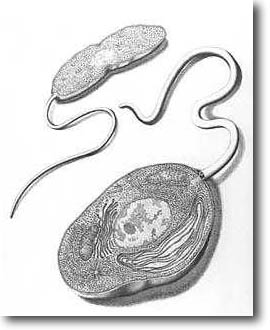| |||||||||

What Are Protoctists?Concept Note
Protoctists (the smallest called protists) are all living things other than, plants, animals, fungi, and bacteria. Ubiquitous in damp, wet, watery places, these amazingly diverse beings reside everywhere from ocean abysses to ephemeral dewdrops, from moist plant tissues to dark deeps of animal bodies. Some 250,000 different species of protoctists are estimated to exist today!
The earlier joint venture of sluggish fermenting bacteria with microbial speedster spirochetes may have been a prime mover in the development of protoctists. Partners for some time, this hardy combination forms permanent attachments to a new larger cell and gets it moving. Some slide inside the cell and eventually become little organs of motility for that cell.
Some mergers also take oxygen-respiring bacteria as partners. These consortia set the stage for two more great Kingdoms of life: Animals and Fungi. Not about to be left out, cyanobacteria join the fray and convert many protists to photosynthesis. This distinguished clan, the algae, expands, eventually giving rise to the great Kingdom of Plants.
|
All Earth life consists of only two kinds of cells: the prokaryote (pronounced pro_CARRY_oat), which has no nucleus, and the eukaryote (pronounced you-CARRY-oat), which does. All protoctists, animals, plants, and fungi are eukaryotes. The two cell classifications mark a
great divide in all Earth life. Bacteria founded the eukaryotes through a symbiotic merger, creating the great chasm. (Illustration by
Christie Lyons)
|
|
Glossary | Home | Questions or comments, E-mail the Webmaster All contents © Foundation For Global Community |
|